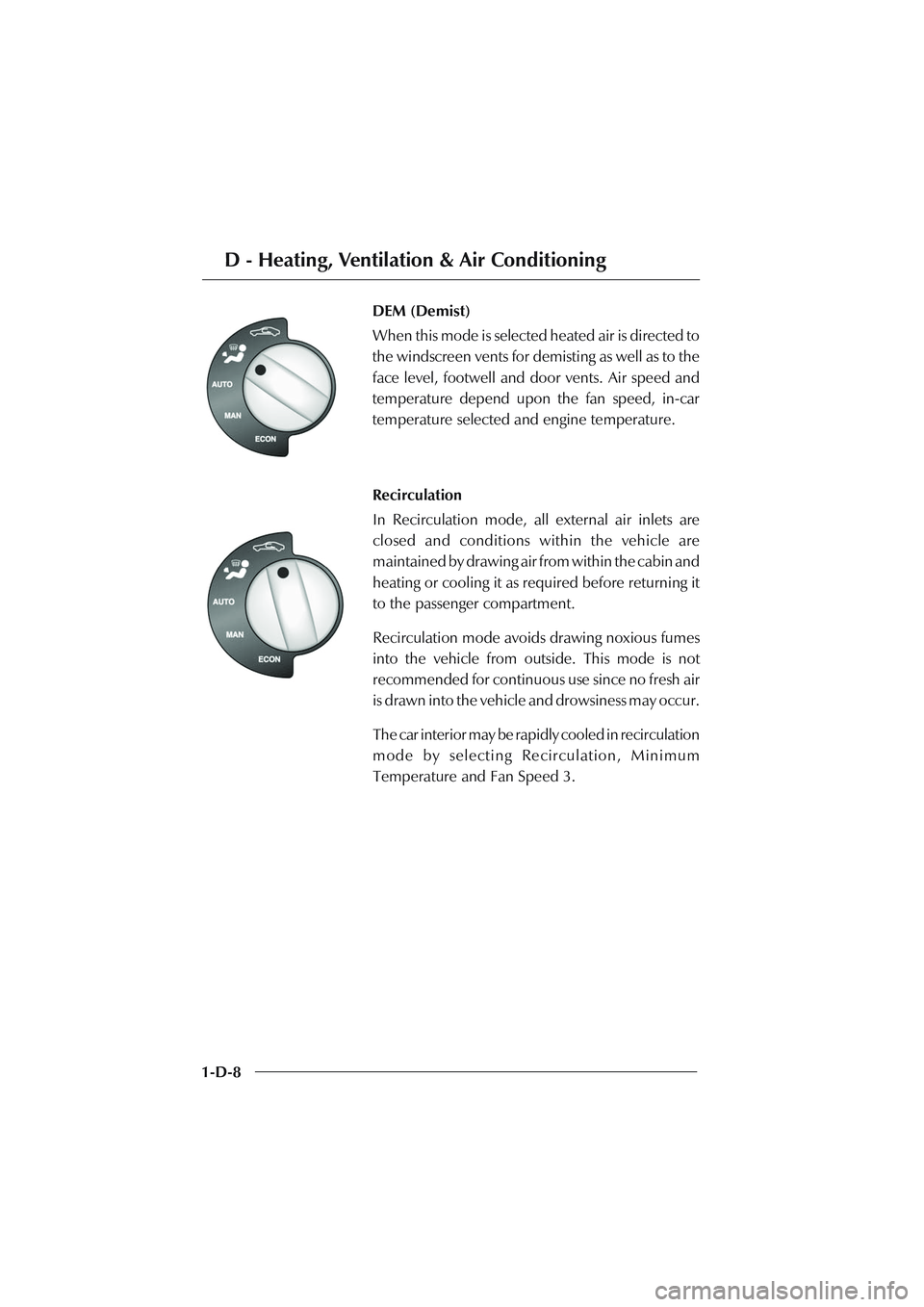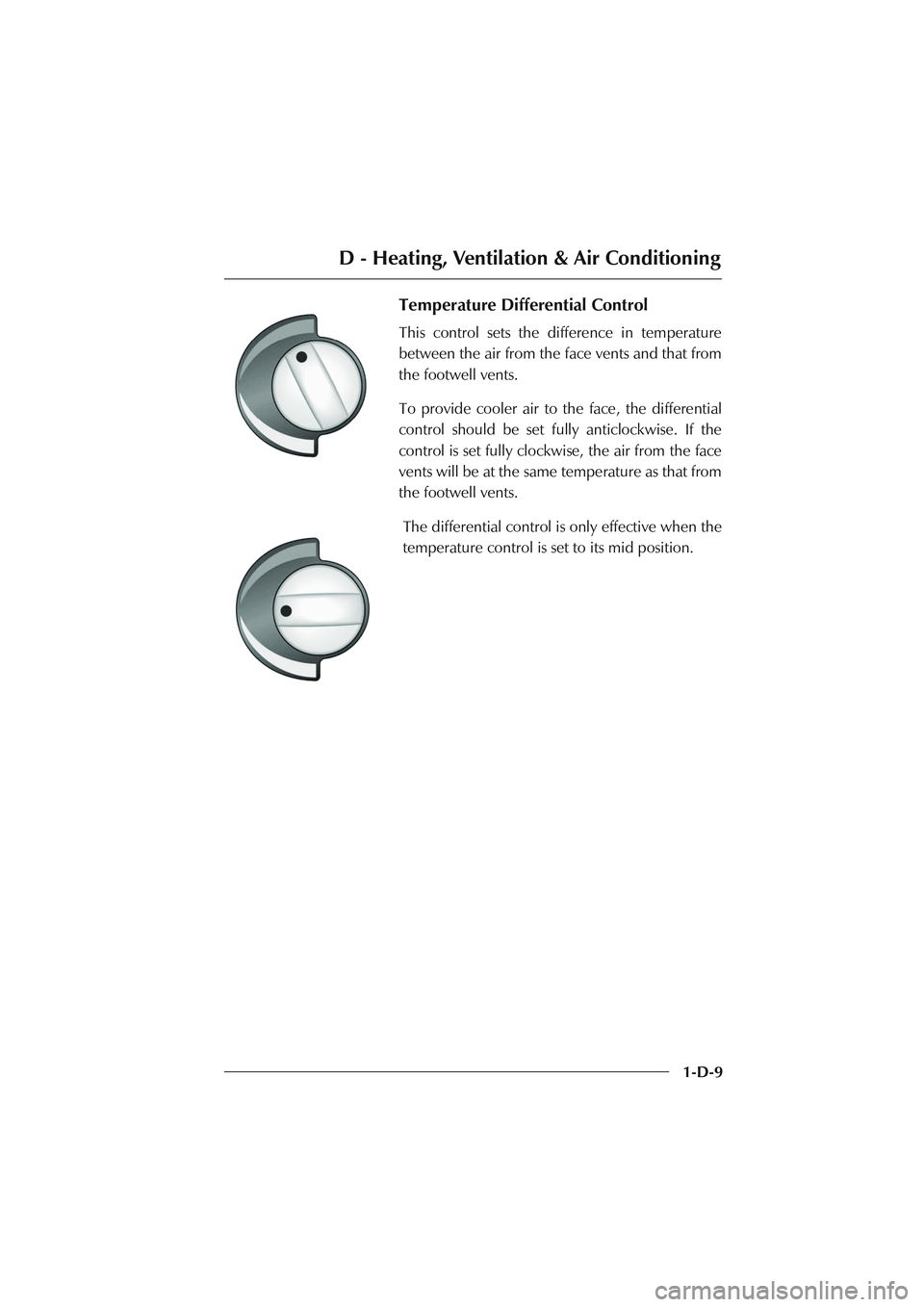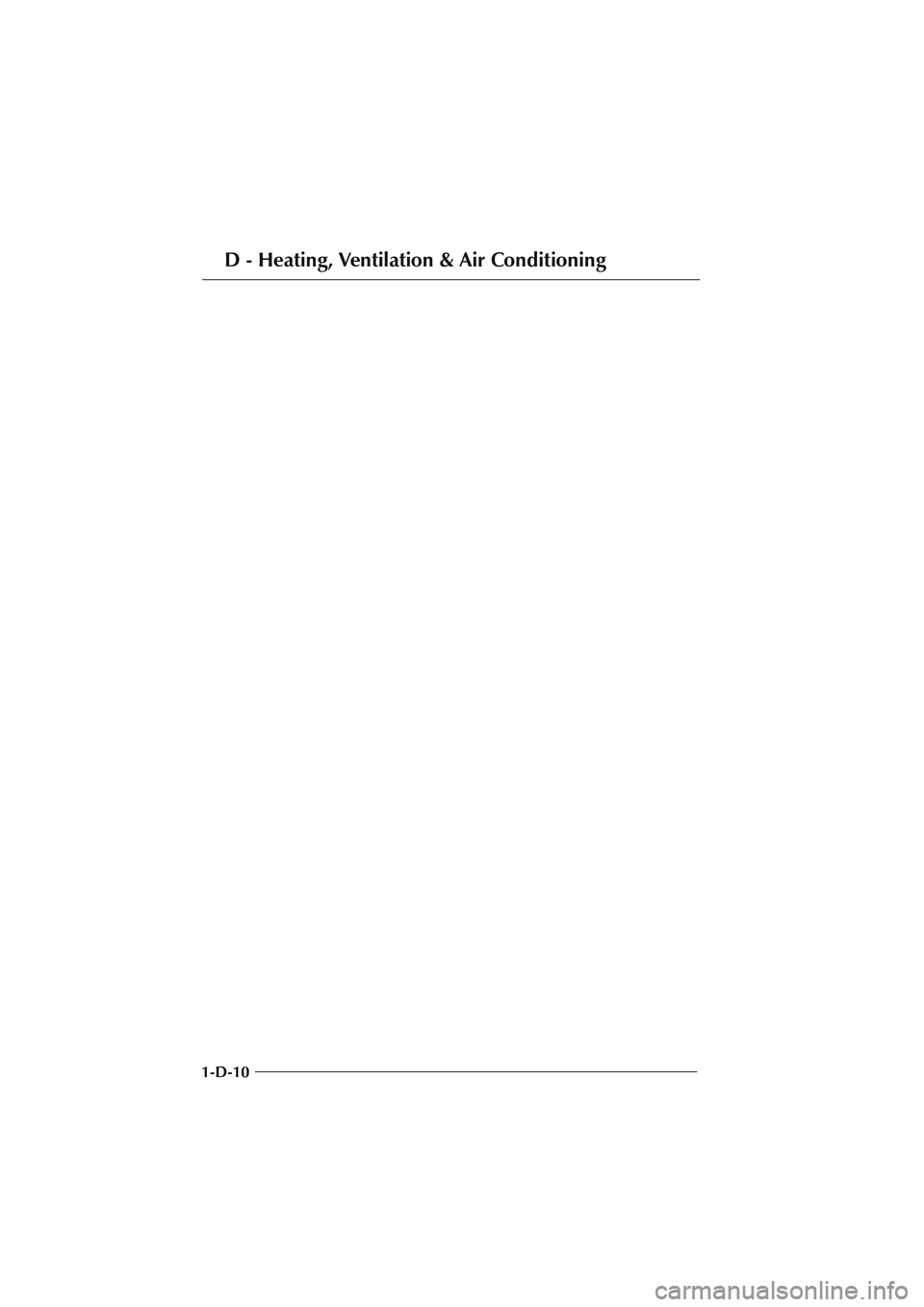air condition ASTON MARTIN DB AR1 Q 2003 Owners Guide
[x] Cancel search | Manufacturer: ASTON MARTIN, Model Year: 2003, Model line: DB AR1 Q, Model: ASTON MARTIN DB AR1 Q 2003Pages: 279, PDF Size: 3.77 MB
Page 96 of 279

D - Heating, Ventilation & Air Conditioning
1-D-7 MAN (Manual)
In Manual mode, the air delivered from the vents
remains at the temperature set on the temperature
control regardless of the temperature inside the
passenger compartment. In this mode, incoming
air is also dehumidified and blended.
AUTO Control
This is the automatic mode of operation in which
the heating and cooling functions of the system
operate automatically, as required, to maintain
the selected in-car temperature. In this mode,
incoming air is also dehumidified and blended.
Note: If the incoming air requires little heating or cooling when in AC mode, the
centre vent will close reducing the air flow in the upper part of the passenger
compartment. If more airflow is required, the Demist function can be used to
provide the same temperature level but with increased air flow to the windscreen
vents.
Page 97 of 279

D - Heating, Ventilation & Air Conditioning
1-D-8DEM (Demist)
When this mode is selected heated air is directed to
the windscreen vents for demisting as well as to the
face level, footwell and door vents. Air speed and
temperature depend upon the fan speed, in-car
temperature selected and engine temperature.
Recirculation
In Recirculation mode, all external air inlets are
closed and conditions within the vehicle are
maintained by drawing air from within the cabin and
heating or cooling it as required before returning it
to the passenger compartment.
Recirculation mode avoids drawing noxious fumes
into the vehicle from outside. This mode is not
recommended for continuous use since no fresh air
is drawn into the vehicle and drowsiness may occur.
The car interior may be rapidly cooled in recirculation
mode by selecting Recirculation, Minimum
Temperature and Fan Speed 3.
Page 98 of 279

D - Heating, Ventilation & Air Conditioning
1-D-9
Temperature Differential Control
This control sets the difference in temperature
between the air from the face vents and that from
the footwell vents.
To provide cooler air to the face, the differential
control should be set fully anticlockwise. If the
control is set fully clockwise, the air from the face
vents will be at the same temperature as that from
the footwell vents.
The differential control is only effective when the
temperature control is set to its mid position.
Page 99 of 279

D - Heating, Ventilation & Air Conditioning
1-D-10
Page 140 of 279

F - Owner Maintenance
1-F-31
WARNINGS:
To help avoid personal injury, do not use open flame, smoke, or cause an electric
spark when checking the battery, as gas generated by the battery is flammable
and can explode. Always shield your eyes and avoid leaning over the battery.
Do not ingest battery acid or fumes. If battery acid is ingested, drink large
quantities of water or milk followed by milk of magnesia, beaten egg or vegetable
oil. Call for medical assistance immediately.
Do not let battery acid come into contact with skin, eyes, hair, fabric or painted
surfaces. A solution of warm soapy water and baking soda may help neutralise
acid.
Used batteries contain sulphuric acid, lead and other potentially hazardous
materials. Dispose of unwanted batteries in authorised waste disposal facilities.
DO NOT discard unwanted batteries in household waste.
Quiescent Battery Drain
Any power drain from a battery after the ignition is switched off is referred
to as 'quiescent battery drain'. Your DB AR1, in common with many modern,
high technology motor cars, contains electronic circuits and sub-systems
which must be left activated at all times. For example, the clock, security
systems and in-car entertainment system continue to drain battery power
even with the ignition switched off. This quiescent drain will discharge a fully
charged new battery in approximately 30 days unless recharged by normal
engine running or an independent battery charger.
It is therefore vital that, when leaving your car unused for extended
periods, you use the battery disconnect switch to minimise quiescent
drain and that you use the battery conditioner to maintain battery
charge level.
Page 148 of 279

F - Owner Maintenance
1-F-39
Fuse Lists
Passenger Footwell Fusebox - Right Hand
F1 5A Passive Anti-Theft Module
F2 20A Cigar Lighter
F3 10A Diagnostic Sockets, Radio, Air Conditioning, Driver's
Door Mirror and Window
F4 5A Seat Switches and Heaters
F5 10A Indicator Flasher
F6 10A Ignition Coils 1-6
F7 10A Interior Lamp Cluster
F8 10A Ignition Coils 7-12
F9 20A RHS Seat Heater Relay, RHS Seat Module
F10 10A Dimmer, Passive Anti-Theft Module, Radio
F11 10A Door Mirrors
F12 5A Diagnostic Sockets
F13 25A Not used
F14 10A Hazard Flasher Unit
F15 20A Wiper Logic Module and Wiper Stalk
F16 30A ABS Control Unit
F17 20A Wiper Motor, Logic Module and Wiper Stalk
F18 30A ABS Control Unit
F19 10A Air Conditioning LH Blower Motor
F20 5A Gearshift Interlock Module, Traction Control Switch,
Interior, Map & Courtesy Lamps
F21 10A Air Conditioning RH Blower Motor
F22 10A Powertrain and Transmission control Modules - Keep
Alive Memory
Page 149 of 279

F - Owner Maintenance
1-F-40
Passenger Footwell Fusebox - Left Hand
F1 15A Accessory Terminal
F2 10A Transmission Control Module, Gearshift Interlock
Module, PRND Switch
F3 5A Headlamp Relay, Instrument Pack, Dimmer Unit
F4 10A Multi Function Unit, Air-Conditioning In-Car Sensor,
Anti-Lock Brakes Control Unit
F5 5A Traction Control Switch, Alternator Regulator, Heated
Front Screen Control
F6 10A Rear Fog Switch, RH Dip Beam
F7 30A Starter Relay
F8 10A LH Dip Beam
F9 20A LHS Seat Heater Relay, LHS Seat Module
F10 40A Heated Front Screen Controller
F11 10A RH Horn
F12 30A LH Rad Cooling Fan
F13 10A LH Horn
F14 30A RH Rad Cooling Fan
F15 30A Primary Powertrain Control Module RHS
F16 10A Multi-Function Unit, Central Locking Module, Air
Conditioning Control Panel, Alarm Sounder
F17 30A Secondary Powertrain Control Module LHS
F18 5A Interior Map Lights, Instrument Pack,
RH Rad Module
F19 10A RH Main Beam
F20 20A Window Lift Cut Out, Accessory Terminal,
Air Conditioning Clutch Relay
F21 10A Instrument Pack, LH Main Beam
F22 25A Front Fog Relay
Page 162 of 279

F - Owner Maintenance
1-F-53 Window Controller Memory Check
With the alarm off and the doors unlocked, open and then close each door
in turn. If the door window drops on opening and rises on closing the door,
the window controller memory is good. If the windows do not drop and rise
correctly, reset the window controllers as follows:
Window Controller Memory Reset Procedure
1. Sit in the drivers seat with the doors closed. Turn on the ignition switch.
2. Press and hold down the window Down button until the window drops
to its maximum down position in one movement.
3. Press and hold the window Up button until the window rises to its
maximum up position in one movement.
4. Switch off the ignition, step out of the car and close the doors. Perform
the Window Controller Memory Check to ensure that the window
maximum up and down positions have been correctly reset.
Headlamp Ventilation
In very humid conditions some condensation may accumulate within the
headlamp pod enclosures whilst the engine is stopped. When the vehicle
is running and the air conditioning is switched on, the headlamp pod
enclosures are automatically vented and any condensation will clear within
a few minutes.
For rapid headlamp ventilation, use the following settings: A/C On, Fan
speed 3, Interior vents all closed. If the condensation does not clear quickly,
consult your Aston Martin dealer.
Page 167 of 279

F - Owner Maintenance
1-F-58
Storing the Car - Recommendations
Note: These recommendations apply to new and pre-owned cars either in
Dealer or customer ownership.
When ever the car is not in use always cover the car with it's fabric cover.
If the vehicle is not to be used for periods up to six months it should be stored
in a dry, well ventilated building.
Drive the car for a sufficient distance to warm the oil in the engine, torque
convertor, transmission and final drive unit; this ensures complete lubrication
of the internal components.
Check the engine coolant level. Top up if necessary with the correct
antifreeze/water solution.
In order to take the weight off the tyres, raise the car with a jack and place
supports under the front and rear suspension.
If the vehicle is not raised from the ground, increase the tyre pressures to 3.4
bar 340 kpa 50 psi. Cover the tyres to exclude any light. Rotate the wheels
1/4 turn every month to avoid tyre flat spots.
The battery should be removed and cleaned. Fully charge the battery on a
trickle charger and recharge once a month.
Once a month
Reconnect the battery and ventilate the storage area. Start and run the
engine until fully warmed up. Check that there are no fluid leaks. Check
and correct the tyre pressures if necessary.
Run the Air Conditioning system to keep the internal parts of the Air
Conditioning system lubricated.
Page 168 of 279

F - Owner Maintenance
1-F-59 When returning the car to normal service, set the tyre pressures to normal
specification before driving on the road.
Extended Storage
For storage periods exceeding six months the following additional measures
are recommended;
Run the car until there is as small a quantity of fuel in the tank as is practical
for storage purposes.
Caution: Do Not Drain The Fuel System
Add Engine Oil to the remaining fuel in the tank to ensure a concentration
of 2% (i.e. 20ml per 1 litre of fuel) and then run the engine for not less than
ten minutes to circulate the mixture thoroughly through the entire fuel
system.
Inspect the rubber connections of the cooling system and have them
renewed if necessary.
Wash the bodywork of the car thoroughly and repair any paint
blisters or patches of rust in order to prevent any further deterioration.
Apply a suitable polish.
Clean the carpets and upholstery thoroughly. Dust them with an
anti-moth powder and store in a dry place. Treat all leather upholstery
with an appropriate leather conditioner.
If the storage building is dry leave the car windows slightly open. If
there is any tendency towards dampness close the car doors and
windows and place an anti-moisture compound such as Silica desiccant
bags in an open metal container inside the car.
Cover the car with it's fabric cover.